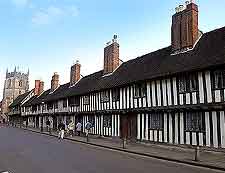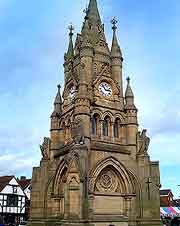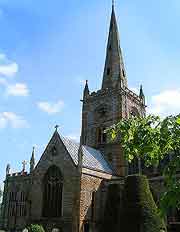Stratford upon Avon History Facts and Timeline
(Stratford upon Avon, Warwickshire, England)

Mention Stratford upon Avon and you can't but help think of its most famous bard William Shakespeare. However, this old town has a fascinating history that extends much further back than the 16th century.
The town has its roots in Anglo-Saxon times. Indeed, Stratford upon Avon's name is derived from a mixture of the Celtic and Saxon languages and simply means 'a river that is crossed by a ford'.
A Medieval Town
Up until the early Middle Ages, Stratford upon Avon had stayed little more than a village. With the arrival of the Normans, it gradually expanded into a town and enjoyed all the benefits of lively commerce and trading. From 1196, the right for the town to hold a weekly market was granted, allowing it to deal in local produce, and a new town centre quickly grew up around the market.
By the end of the Middle Ages, the town of Stratford upon Avon was a centre of trade for the region. Among its numbers were many craftsmen. Its wealthier townsfolk could now be educated at a new grammar school. There were also several religious Guilds, which were to have a significant impact on the town's working life. The Guildhall was built in 1418 and it was from here that the administration of Stratford upon Avon was directed by the 'Gild of the Holy Cross'. The Reformation was to bring the Gild's pre-eminence to an end in 1547.

Stratford's Early Modern History
In the early 16th century, the town witnessed the arrival of its most famous son. William Shakespeare was born here in April 1564. The house in which he grew up, on Henley Street, survives to this day. His father was a man of good standing and held the office of Bailiff of the Borough in 1568. At the age of 18 years, Shakespeare married Anne Hathaway. After establishing his acting career in London, he returned to his home town, setting up house here in 1597. Shakespeare died in 1616 and was buried in the town's Holy Trinity Church.
In the English Civil War, Stratford upon Avon was occupied by Parliamentarian soldiers. During their time here, they almost destroyed the Town Hall and succeeded in damaging the town bridge. In the century that followed, the town enjoyed a period of relative economic recovery. During the 1760s, David Garrick helped to revive Shakespeare's popularity and in turn, he helped to further restore the town's fortunes. He created the idea of a Shakespearean Festival, to be held in the town as near to the bard's birthday as possible. The Festival continues to be held today.

19th Century History to the Present
During the 19th century, the town saw the arrival of many new innovations and much industrial activity. A canal was cut as early as 1816. An early form of the railway was used from the 1820s. It consisted of horse-pulled carriages between Stratford upon Avon and Shipston-on-Stour, being used to carry coal and corn.
The steam railway finally came to the town in 1859, bringing with it crowds of tourists from nearby cities such as
Birmingham and
Coventry. Tourism was an industry that was largely centred around Shakespeare, although other attractions included the annual Mop Fairs and the Regatta. Victorian business wealth went towards funding many cultural and public buildings, including the Free Library in Henley Street. In 1847, Shakespeare's birthplace was turned into a monument.
In 1932, the Royal Shakespeare Theatre was built. Today, Stratford upon Avon remains a busy tourist destination. It has also maintained its heritage as a market town, with four cattle shows held here every year, as well as weekly markets. The Stratford Mop is still held every October, although since World War One, it's taken the form of a funfair rather than a traditional 'hiring fair'.
 Mention Stratford upon Avon and you can't but help think of its most famous bard William Shakespeare. However, this old town has a fascinating history that extends much further back than the 16th century.
Mention Stratford upon Avon and you can't but help think of its most famous bard William Shakespeare. However, this old town has a fascinating history that extends much further back than the 16th century.
